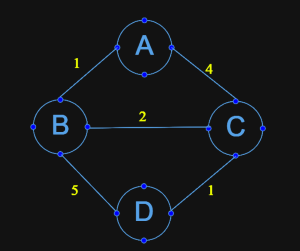Dijkstra’s Algorithm (Shortest Path)
Dijkstra’s algorithm is a classic method for finding the shortest path from a starting node to every other node in a weighted graph (with non-negative edge weights).
How It Works
- Initialization
- Distance Map: Create an object
distwhere every node’s distance is set to infinity (∞), except the start node which is set to 0. - Priority Queue: Use a priority queue (or min-heap) to store nodes ordered by their current shortest distance.
- Previous Map: Optionally, maintain a
previousmap to keep track of the best preceding node for each node (useful for reconstructing the shortest path).
- Distance Map: Create an object
- Main Loop
While the priority queue is not empty:- Extract Minimum: Remove the node
uwith the smallest distance from the queue. - Relaxation: For each neighbour
vofu:- Compute an alternative distance:
alt = dist[u] + weight(u, v) - If
altis less thandist[v]:- Update
dist[v]toalt. - Set
previous[v]tou. - Add or update
vin the priority queue with the new distance.
- Update
- Compute an alternative distance:
- Extract Minimum: Remove the node
- Result Extraction
- After processing, the
distobject contains the shortest distances from the start node to every other node. - To reconstruct the shortest path from the start node to a target node, backtrack using the
previousmap.
- After processing, the
Example Graph
Consider the following graph:

- Edges:
- A → B (weight = 1)
- A → C (weight = 4)
- B → C (weight = 2)
- B → D (weight = 5)
- C → D (weight = 1)
Goal: Find the shortest path from node A to node D.
Step-by-Step Execution
- Initialization:
dist = { A: 0, B: ∞, C: ∞, D: ∞ }previous = {}- Priority Queue:
[(A, 0)]
- Processing Node A:
- Dequeue A (distance = 0).
- For neighbour B:
alt = 0 + 1 = 1→ Updatedist[B] = 1,previous[B] = A.
- For neighbour C:
alt = 0 + 4 = 4→ Updatedist[C] = 4,previous[C] = A.
- Queue becomes:
[(B, 1), (C, 4)].
- Processing Node B:
- Dequeue B (distance = 1).
- For neighbour C:
alt = 1 + 2 = 3→ Updatedist[C] = 3,previous[C] = B.
- For neighbour D:
alt = 1 + 5 = 6→ Updatedist[D] = 6,previous[D] = B.
- Queue becomes:
[(C, 3), (C, 4), (D, 6)]
(Duplicates in the queue are handled appropriately in a proper priority queue implementation.)
- Processing Node C:
- Dequeue C (distance = 3).
- For neighbour D:
alt = 3 + 1 = 4→ Updatedist[D] = 4,previous[D] = C.
- Queue becomes:
[(D, 4), (D, 6)].
- Processing Node D:
- Dequeue D (distance = 4).
- D has no neighbours needing updates.
- The queue is now empty.
- Reconstructing the Shortest Path from A to D:
- Start at D:
previous[D] = C - Then C:
previous[C] = B - Then B:
previous[B] = A - Path: A → B → C → D with a total distance of 4.
- Start at D:
Category:No additional categories provided
Programming Language: - Java
Reference Link:
https://drawtocode.vercel.app/problems/dijkstras-algorithm
Java
Output:
Loading component...
Loading component...